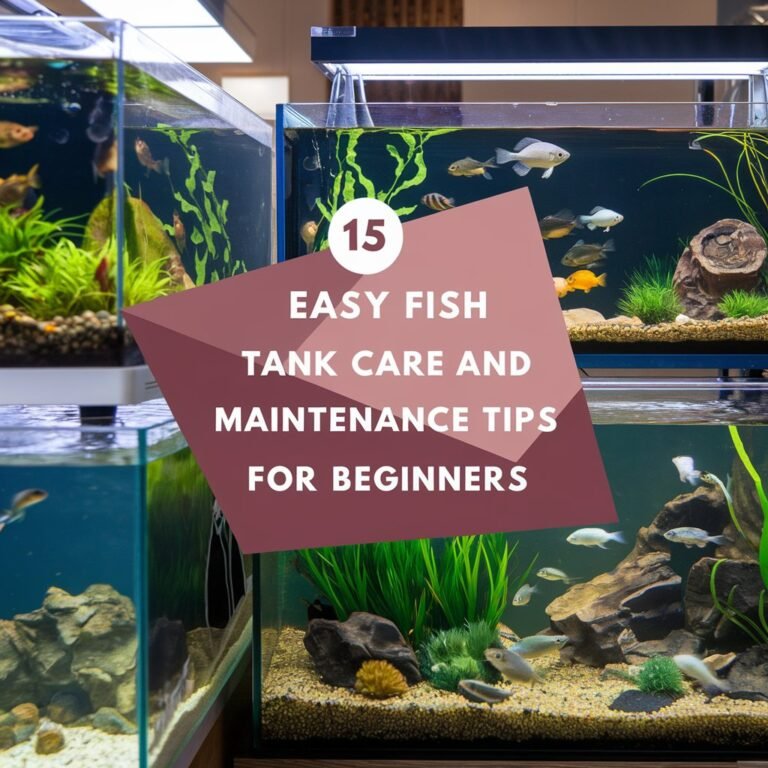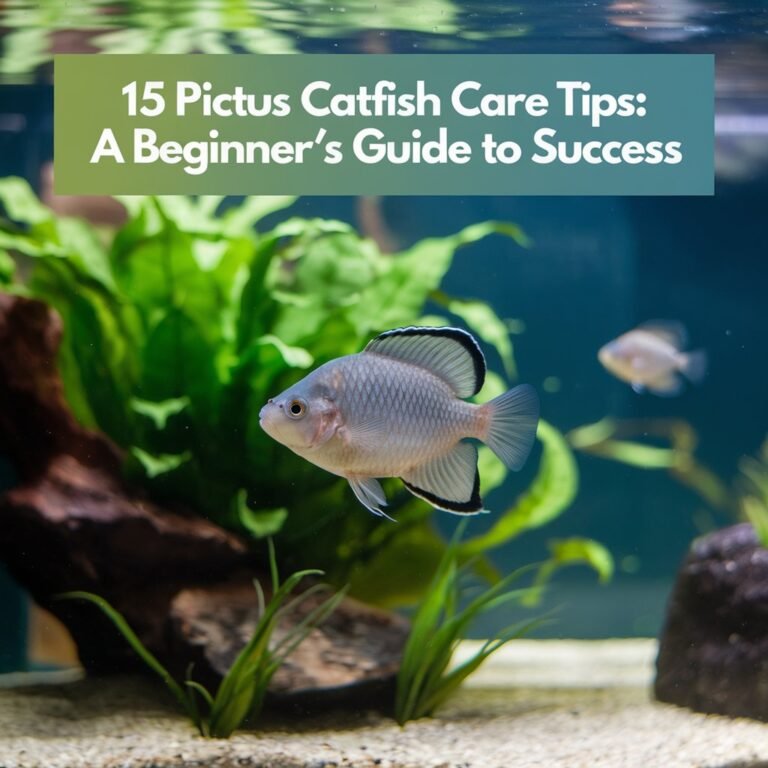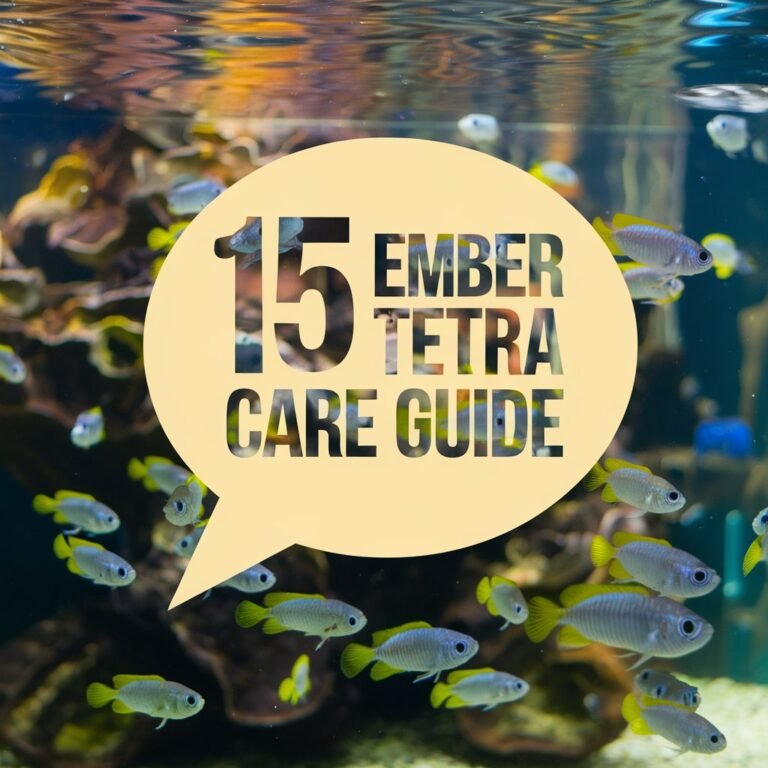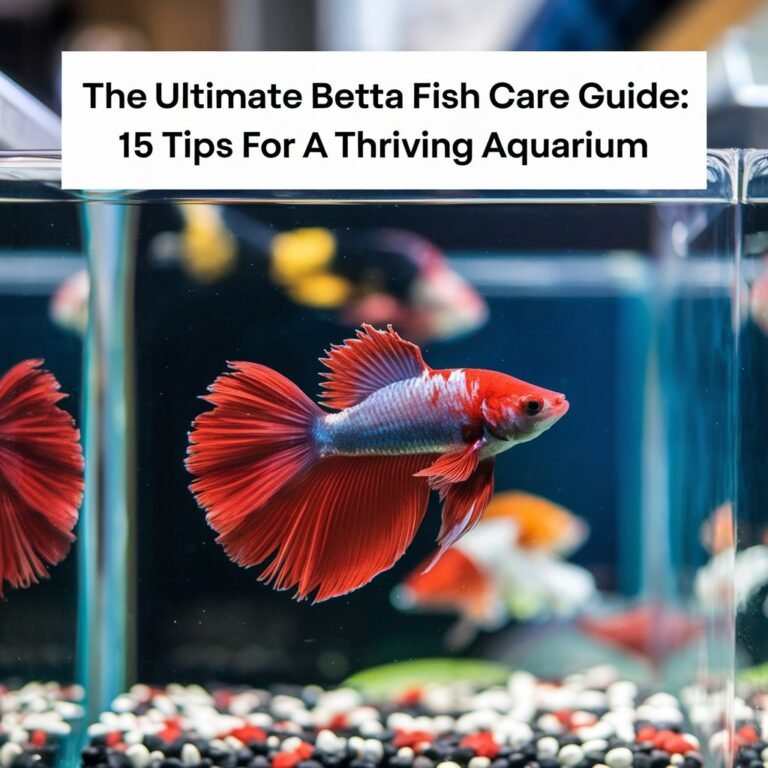15 Kuhli Loach Care Guide: A Comprehensive Guide
You’ve decided to bring a Kuhli loach into your aquarium, but you’re not sure where to start. Creating a thriving environment for these unique fish requires attention to detail and a solid understanding of their needs.
With their distinctive eel-like bodies and nocturnal habits, Kuhli loaches have specific requirements that must be met. By considering factors like tank size, water quality, and diet, you can help your Kuhli loach live a happy and healthy life. But what are the most critical factors to focus on, and how can you guarantee you’re providing the best possible care for your new pet?
In A Nutshell
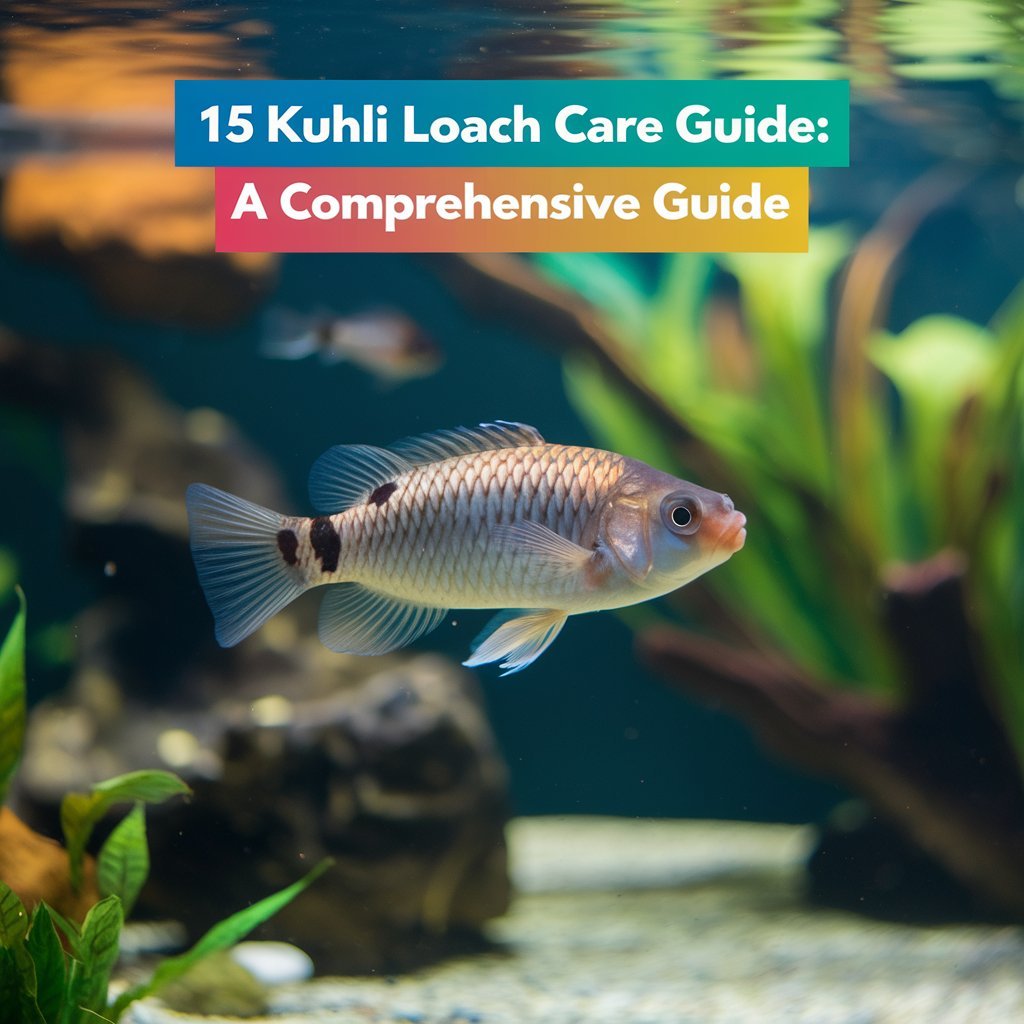
- Maintain a minimum tank size of 20 gallons with easy-to-care-for aquatic plants like Java moss or Anubias.
- Perform daily tasks, including turning on and off equipment, feeding Kuhli loaches, and inspecting the tank.
- Provide a temperature range of 22-28°C (72-82°F) and stable pH levels between 6.0 and 7.0 for peak health.
- Use a water testing kit to ensure key parameters like ammonia and nitrite levels are 0 ppm and nitrate <20 ppm.
- Feed Kuhli loaches a varied diet of live, frozen, and commercial foods, including live foods like bloodworms and earthworms.
Choosing the Right Tank Size
When setting up a tank for Kuhli loaches, you’ll want to select a tank that’s large enough to accommodate these active, nocturnal fish.
A minimum tank size of 20 gallons is recommended, as Kuhli loaches are known to be active swimmers and can grow up to 4 inches in length. A larger tank will also provide ample space for your Kuhli loaches to hide, seek, and school.
When choosing tank mates, it’s vital to weigh fish compatibility.
Kuhli loaches are generally peaceful and can be kept with other community fish, but they prefer to be in schools of their own kind. Avoid keeping them with fin-nipping or aggressive fish, as this can cause stress and reduce their lifespan.
With regard to aquatic plants, opt for plants that are easy to care for and can thrive in low-light conditions, such as Java moss or Anubias.
These plants will help to create hiding places and visual barriers for your Kuhli loaches, making them feel more secure and reducing aggression. By selecting the right tank size and compatible tank mates, you’ll create a thriving environment for your Kuhli loaches to live and flourish.
Water Temperature Requirements
Twenty degrees Celsius is the lower limit for Kuhli loach water temperature requirements, and you’ll want to maintain a temperature range of 22-28°C (72-82°F) for peak health.
This temperature range allows your Kuhli loaches to thrive, promoting ideal metabolism and activity levels. It’s crucial to avoid sudden changes in water temperature, as Kuhli loaches are sensitive to temperature fluctuations.
Seasonal fluctuations in temperature can be detrimental to your Kuhli loaches’ health.
Avoid placing the tank near windows or doors, where temperature gradients can form. Temperature gradients can cause stress and discomfort in Kuhli loaches, leading to weakened immune systems and increased susceptibility to disease.
To maintain a stable water temperature, use a high-quality aquarium heater and a thermometer to monitor the temperature.
Regularly check the temperature to verify it remains within the ideal range. By maintaining a stable and ideal water temperature, you’ll help create a healthy environment for your Kuhli loaches to grow and thrive.
Monitor the temperature closely, and make adjustments as necessary to guarantee your Kuhli loaches’ ideal health and well-being.
Optimal Water Hardness Levels
A water hardness level of 5-10 dGH is ideal for Kuhli loaches, as it closely mimics their natural environment.
To measure water hardness, you’ll need a water hardness tester. These kits are usually available at pet stores and come in the form of test strips or liquid solutions.
Using one will give you an accurate reading of your aquarium’s water hardness level.
Maintaining soft to moderately hard water benefits Kuhli loaches.
In the wild, these fish live in areas with slow-moving water, such as streams and rivers. These environments tend to have lower water hardness levels.
In an aquarium, soft water can promote healthier fish and improve their overall quality of life. You can achieve the ideal water hardness level by using reverse osmosis (RO) water or dechlorinated water.
It’s essential to avoid water with extremely high or low hardness levels.
This can lead to stress, disease, and even death. If your aquarium water is too hard, consider using water conditioners or replacing it with softer water.
Regularly testing your aquarium’s water hardness level using a water hardness tester will help you maintain a healthy environment for your Kuhli loaches.
Ph Levels for Kuhli Loaches
Kuhli loaches thrive in environments with stable pH levels, which you can achieve by monitoring and adjusting their aquarium’s acidity.
pH levels between 6.0 and 7.0 are ideal for Kuhli loaches, closely mimicking the conditions they experience in their natural habitats. These levels allow your loaches to maintain peak physiological functions, such as digestion and respiration.
It’s essential to note that Kuhli loaches have a moderate acidic tolerance, meaning they can withstand slight pH fluctuations in the acidic range.
However, they exhibit alkaline sensitivity, making them more susceptible to pH levels above 7.0. Avoid exposing your loaches to prolonged periods of high pH, as this can lead to stress, weakened immunity, and increased susceptibility to diseases.
To maintain the ideal pH range, use a pH test kit to regularly monitor your aquarium’s acidity.
Perform water changes with dechlorinated water that matches the desired pH level. Additionally, incorporate pH-stabilizing materials, such as driftwood or peat, to help maintain stable pH levels.
Tank Water Movement Requirements
As you set up and maintain your aquarium, it’s crucial to ponder the water movement requirements for your Kuhli loaches.
Kuhli loaches are native to slow-moving rivers and streams in Southeast Asia, where water circulation is moderate to low. In your aquarium, you should aim to replicate these natural current patterns.
To achieve this, you can use a combination of aquarium equipment, such as powerheads, filters, and circulation pumps.
These devices help create gentle water flow and prevent stagnant areas in the tank. It’s imperative to avoid strong currents, as Kuhli loaches aren’t adept swimmers and may struggle to navigate fast-moving water.
When designing your aquarium’s water circulation system, consider the tank’s dimensions and the number of fish.
A general rule of thumb is to aim for a water flow rate of 1-2 gallons per minute (GPM) per 10 gallons of water.
This will help maintain a stable and healthy environment for your Kuhli loaches. By replicating natural current patterns and water circulation, you can create a thriving environment for your fish.
Providing Adequate Hiding Places
Providing your Kuhli loaches with ample hiding places is integral to their well-being, especially considering their natural habitat‘s abundance of submerged vegetation and rocky structures.
In the wild, Kuhli loaches utilize these hiding places to avoid predators, find food, and establish territories.
To replicate this environment, you can incorporate various hiding places into your aquarium. Rock crevices and overhangs can provide your Kuhli loaches with secure hiding spots.
You can use rocks of varying sizes and shapes to create these crevices, and even stack them to create a complex structure.
Additionally, you can use plants with dense foliage, such as Java ferns or Anubias, to provide your Kuhli loaches with a sense of security.
Aquatic plants not only provide hiding places but also help to create a natural environment, which can reduce stress and promote the overall health of your Kuhli loaches.
It is recommended to place hiding places throughout the aquarium, including in the middle and at the bottom.
This will allow your Kuhli loaches to move freely and find a hiding spot whenever they feel the need to.
Kuhli Loach Tankmate Selection
When selecting tankmates for your Kuhli loaches, compatibility is key to maintaining a harmonious aquarium environment.
You’ll want to choose species that are peaceful and non-competitive, as Kuhli loaches are nocturnal and can be stressed by aggressive tankmates. Avoid housing Kuhli loaches with aggressive species, such as fin-nippers or territorial fish, as they can harass and stress your loaches.
Instead, opt for peaceful schools of fish that occupy different water layers. Species like neon tetras, harlequin rasboras, and lemon tetras are good choices, as they swim in the middle and upper water layers, leaving the lower layers for your Kuhli loaches.
You can also consider bottom-dwellers like corydoras catfish or dwarf loaches, which are non-competitive and can coexist with Kuhli loaches.
When introducing new tankmates, do it slowly and under close observation to guarantee compatibility. Monitor your Kuhli loaches’ behavior and watch for signs of stress or aggression.
Best Food for Kuhli Loaches
Choosing the right food for your Kuhli loaches is crucial to maintaining their health and promoting ideal growth.
As nocturnal bottom-dwellers, Kuhli loaches are primarily carnivorous, requiring a diet rich in protein. You’ll want to provide a variety of nutrient-dense foods to guarantee their peak well-being.
Live foods such as bloodworms, brine shrimp, and earthworms are excellent choices, as they mimic the loaches’ natural food sources. These live foods provide essential nutrients, including vitamins, minerals, and proteins.
In addition to live foods, you can also offer high-quality commercial pellets or sticks specifically formulated for loaches.
Frozen options like frozen bloodworms or brine shrimp can be just as nutritious as live foods. When choosing frozen foods, look for products that are free of added preservatives and artificial colorings.
A varied diet that includes a mix of live, frozen, and commercial foods will help guarantee your Kuhli loaches receive the nutrients they need to thrive. By providing a balanced and diverse diet, you’ll be supporting the overall health and well-being of your Kuhli loaches.
A well-nourished loach is better equipped to resist disease and maintain its natural behavior.
Feeding Kuhli Loaches Correctly
Most Kuhli loach owners feed their fish multiple times a day, but a vital aspect is to establish a feeding schedule that meets the unique needs of these nocturnal bottom-dwellers.
Since Kuhli loaches are most active at night, it’s vital to feed them in the evening or just before turning off the aquarium lights. This allows them to forage for food naturally, reducing competition with other diurnal fish.
You should provide a varied diet that includes a mix of sinking pellets, live foods, and frozen options.
Live foods like brine shrimp, bloodworms, and earthworms can be given 1-2 times a week, while frozen options like daphnia and plankton can be offered 2-3 times a week. Sinking pellets can be fed daily, but in moderation to prevent overfeeding.
Monitoring your Kuhli loaches’ food intake and adjusting the feeding schedule accordingly is imperative. Overfeeding can lead to digestive issues and poor water quality.
Substrate and Decoration Tips
A well-designed aquarium environment is essential for the health and well-being of your Kuhli loaches.
When it comes to substrate and decoration, you’ll want to create a natural and stimulating space for your fish. Gravel selection is pivotal, as Kuhli loaches are burrowing fish that spend most of their time digging and hiding.
Choose a fine-grained, smooth gravel that won’t cause injury or damage to their barbels. A depth of 1-2 inches is sufficient, allowing for easy burrowing and exploration.
Plant placement is also essential in creating a natural environment.
Live plants, such as Java moss, Anacharis, and Cryptocorynes, provide hiding places, food, and oxygen for your Kuhli loaches.
Place plants in a way that creates hiding places and visual barriers, allowing your fish to feel secure and relaxed. Avoid over-crowding the tank, as this can lead to stress and competition for resources.
Kuhli Loach Lighting Needs
As you’ve carefully crafted the substrate and plant life in your aquarium, the time has come to ponder the lighting needs of your Kuhli loaches.
Kuhli loaches are nocturnal fish, meaning they’re most active at night, so they don’t require intense lighting. In fact, they prefer subdued lighting, which allows them to feel secure and thrive.
For daytime illumination, you can use low-wattage lighting, such as 1-2 watts per gallon.
This will provide enough light for plant growth and visibility without stressing your Kuhli loaches. Crucial to avoid is direct sunlight, as it can promote algae growth and cause water temperature fluctuations.
Artificial lighting can be used to simulate a natural day-night cycle.
You can use LED or T5 lights, which are energy-efficient and produce minimal heat. Aim for a photoperiod of 10-12 hours of light and 12-14 hours of darkness.
This will help regulate your Kuhli loaches’ circadian rhythms and promote healthy behavior. By providing the right lighting conditions, you’ll create a comfortable environment for your Kuhli loaches to thrive.
Tank Maintenance Schedule
Consistency is key to maintaining a healthy aquarium environment for your Kuhli loaches.
A regular tank maintenance schedule helps prevent the buildup of toxins and guarantees prime water conditions. You should perform routine tasks daily, weekly, and monthly to keep your aquarium in pristine condition.
Daily tasks include turning on and off equipment, feeding your Kuhli loaches, and inspecting the tank for any signs of distress or unusual behavior.
Weekly tasks include cleaning the glass walls of the tank with a magnetic algae scraper and replacing 10-15% of the tank water.
You should also inspect the filter media and clean or replace it as recommended by the manufacturer.
Monthly tasks include gravel cleaning, which involves siphoning debris and waste from the substrate, and filter maintenance, which involves cleaning or replacing the filter cartridges.
You should also inspect the tank’s decorations and accessories for any signs of damage or algae buildup and clean them as necessary.
Water Quality Monitoring
Within the delicate ecosystem of your aquarium, monitoring water quality is crucial for maintaining ideal conditions for your Kuhli loaches.
Regular water testing helps prevent toxic buildup, which can be detrimental to your fish’s health. You should test your water for key parameters such as ammonia, nitrite, and nitrate levels.
Perform water testing at least once a week, but ideally every few days, especially after water changes or when introducing new fish.
Use a water testing kit specifically designed for aquariums, as these kits provide accurate readings for the parameters mentioned above. Compare your test results to the recommended water parameters for Kuhli loaches: pH 6.0-7.5, ammonia and nitrite 0 ppm, and nitrate <20 ppm.
If your test results indicate water quality issues, take corrective action immediately. For example, if you detect high ammonia levels, perform a partial water change to dilute the toxin.
Regular water testing and prompt action will help maintain prime water quality, reducing the risk of disease and stress in your Kuhli loaches. Consistent monitoring safeguards a healthy environment, allowing your loaches to thrive.
Handling Kuhli Loach Stress
Maintaining ideal water quality is just one aspect of creating a healthy environment for your Kuhli loaches.
You also need to be aware of stress triggers and implement calming methods to keep your fish thriving. Kuhli loaches are sensitive to sudden changes in water temperature, pH, and chemistry, making them prone to stress.
Other stress triggers include loud noises, aggressive tankmates, and inadequate hiding places. When stressed, Kuhli loaches may exhibit erratic behavior, such as rapid breathing, erratic swimming, or hiding more frequently.
To minimize stress, guarantee your tank is well-planted with plenty of hiding places and visual barriers.
Provide a variety of hiding places, such as rocks, driftwood, and plants, to help your Kuhli loaches feel secure.
You can also use calming methods like reducing lighting or adding calming agents, such as water conditioners, to the tank.
Regular water changes and monitoring of water parameters can also help reduce stress.
By being aware of stress triggers and implementing calming methods, you can create a peaceful environment for your Kuhli loaches to thrive.
A stress-free environment is essential for maintaining the overall health and well-being of your Kuhli loaches.
Common Kuhli Loach Diseases
Kuhli loaches, like other freshwater aquarium fish, are susceptible to various diseases that can compromise their health and well-being.
As a responsible aquarist, you should be aware of the common diseases that can affect your Kuhli loaches. Fungal infections are one of the most common diseases that can affect Kuhli loaches. These infections are usually caused by poor water quality, injury, or stress. You can identify fungal infections by the presence of white, cotton-like growths on the skin or fins of your Kuhli loaches.
Bacterial blooms are another common disease that can affect Kuhli loaches. These blooms are usually caused by poor water quality, overfeeding, or inadequate filtration.
You can identify bacterial blooms by the presence of cloudy or milky water, or by the presence of red or purple lesions on the skin of your Kuhli loaches. To prevent these diseases, you should maintain good water quality, provide a balanced diet, and guarantee that your aquarium is well-filtered.
Regular water changes and monitoring of water parameters can also help prevent the onset of these diseases. By being aware of these diseases, you can take steps to prevent them and keep your Kuhli loaches healthy.
Frequently Asked Questions
Can Kuhli Loaches Live With Betta Fish in a Community Tank?
You’re considering housing Kuhli loaches with betta fish, but beware: betta aggression can be a concern. Guarantee a spacious tank (at least 20 gallons) to minimize territorial behavior and provide ample hiding spots for loaches.
Are Kuhli Loaches Sensitive to Aquarium Salt Additions?
You’ll find kuhli loaches have low salt tolerance, so crucial monitoring of aquatic chemistry is vital when adding aquarium salt, as sudden changes can be detrimental to these sensitive fish, requiring careful acclimation and precise dosing.
How Long Do Kuhli Loaches Live in Captivity on Average?
When you care for kuhli loaches, their life expectancy in captivity averages 10-15 years. However, this depends on your ability to maintain ideal tank conditions, including water quality and suitable temperature, which greatly influence their lifespan.
Can Kuhli Loaches Be Kept With Small Species of Crayfish?
When considering crayfish as tankmates, you’ll need to assess crayfish aggression and compatibility. Some small crayfish species can coexist peacefully, but most are territorial and may harass or prey on Kuhli Loaches, requiring careful evaluation.
Are Kuhli Loaches Active During the Day or Night?
You’ll find kuhli loaches exhibit nocturnal behavior, being most active at night, but they can also display daytime habits, occasionally venturing out during the day, especially in low-light environments or when food is present nearby.
FInal Verdict
By following the guidelines outlined in this exhaustive Kuhli loach care guide, you’ll be able to create a suitable environment for your fish to thrive. Maintaining ideal water parameters, providing adequate hiding places, and ensuring a balanced diet are vital for their health.
Regular water quality monitoring and a well-planned tank maintenance schedule will also help prevent stress and disease. With proper care, your Kuhli loaches will lead a stress-free and healthy life.
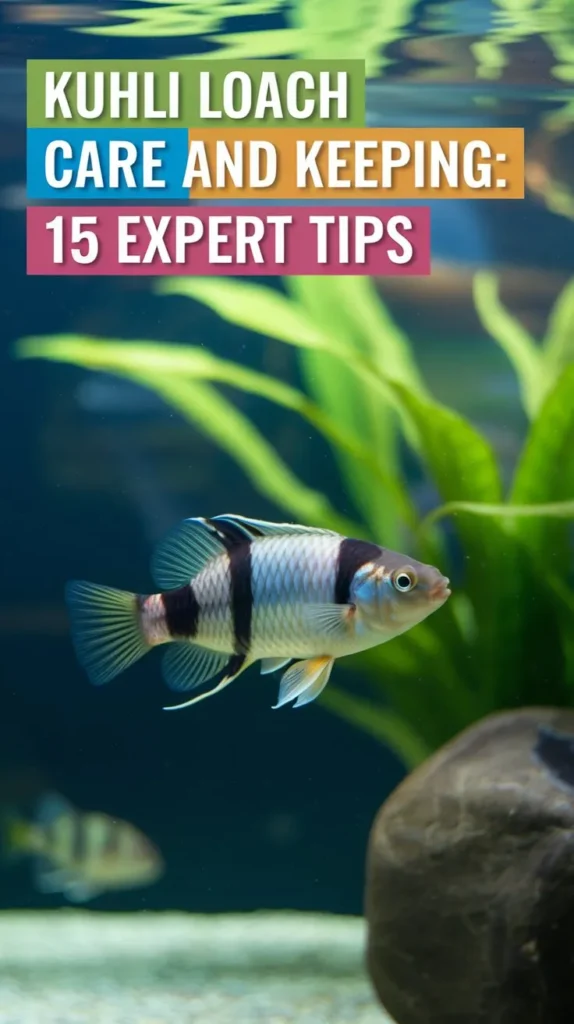

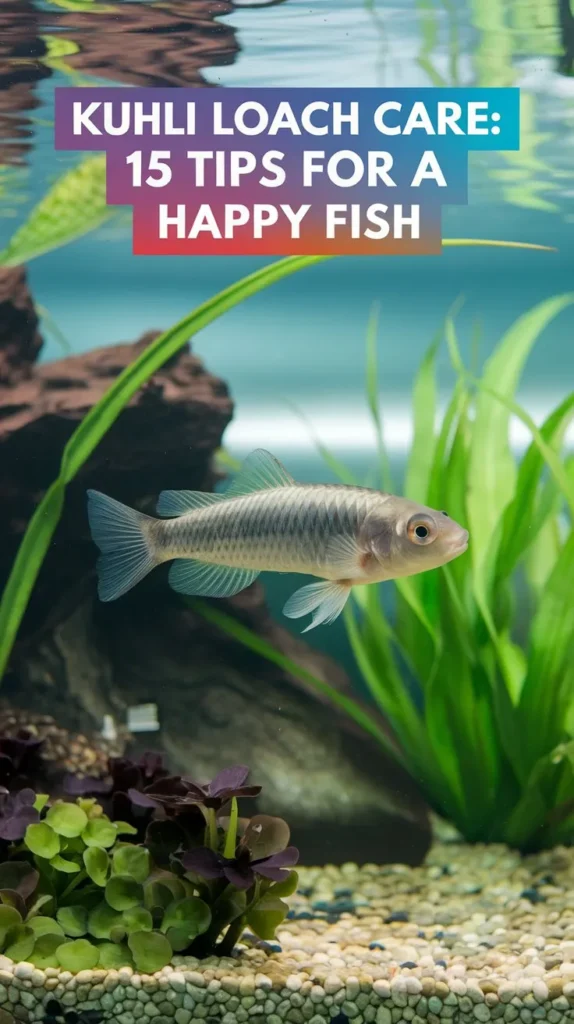
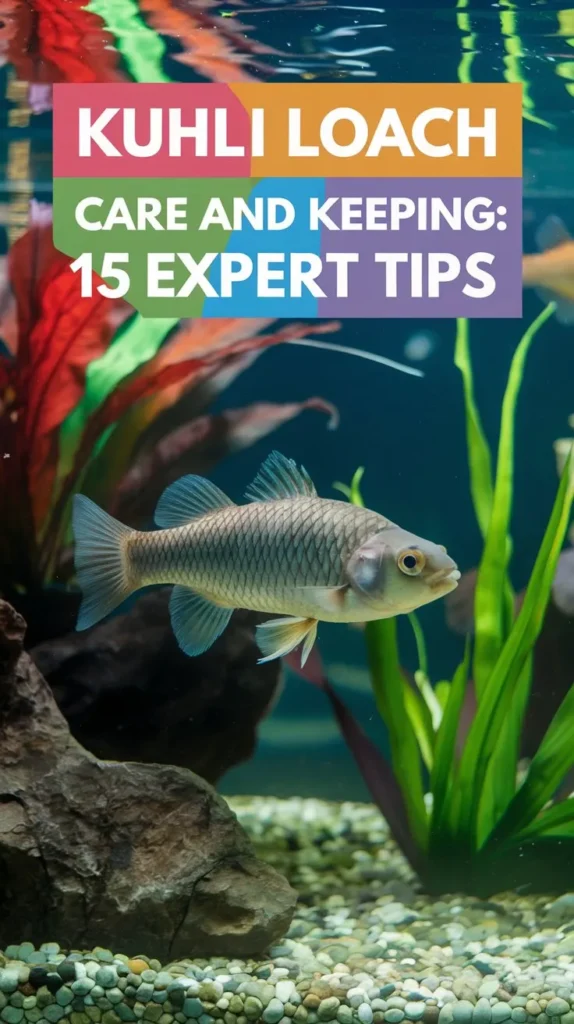
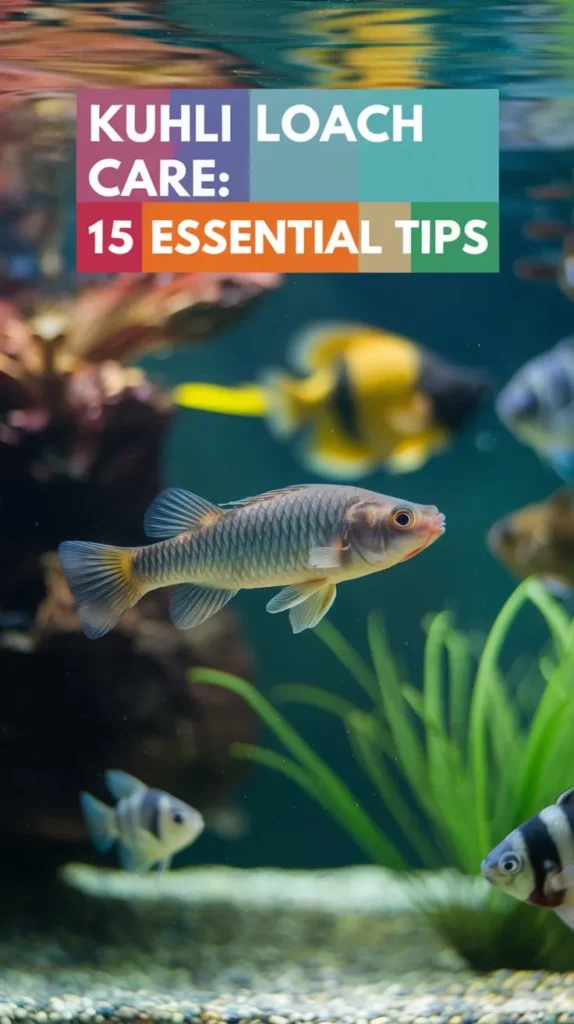
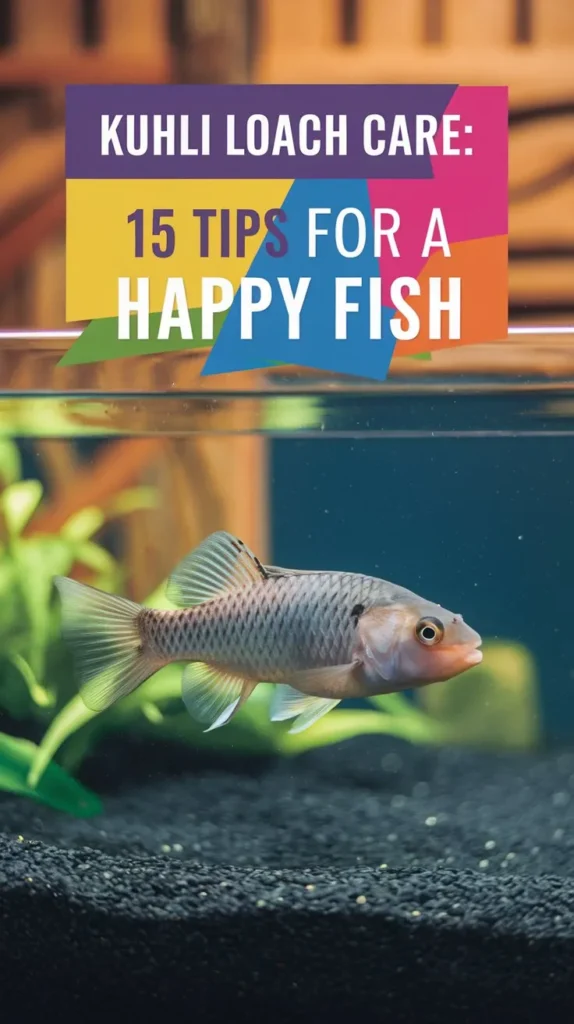
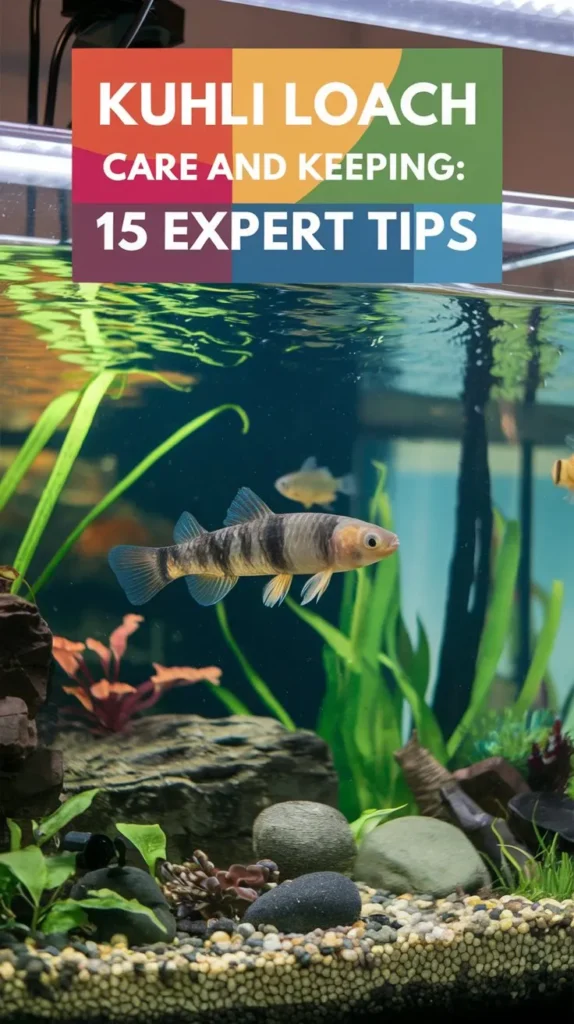

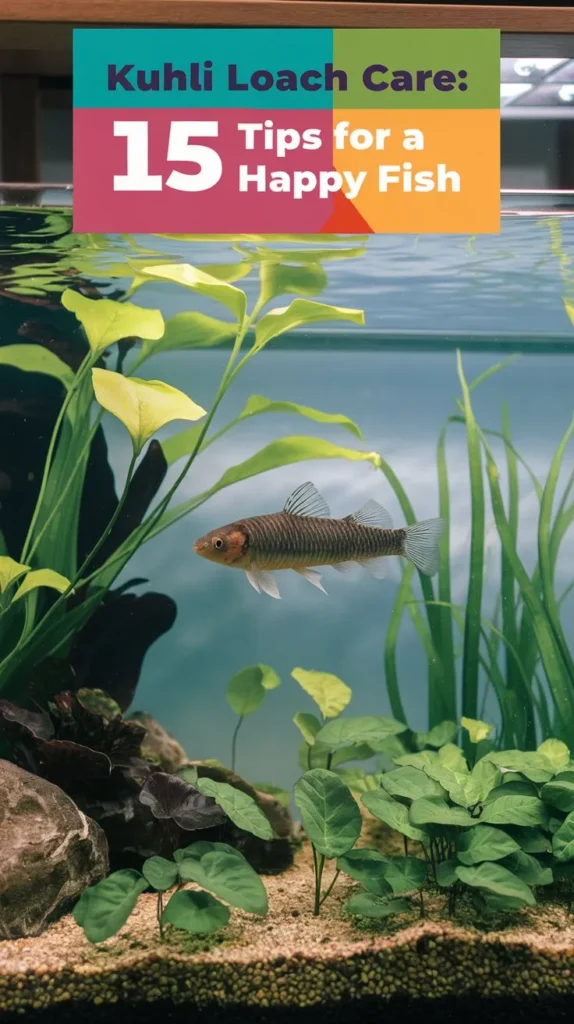

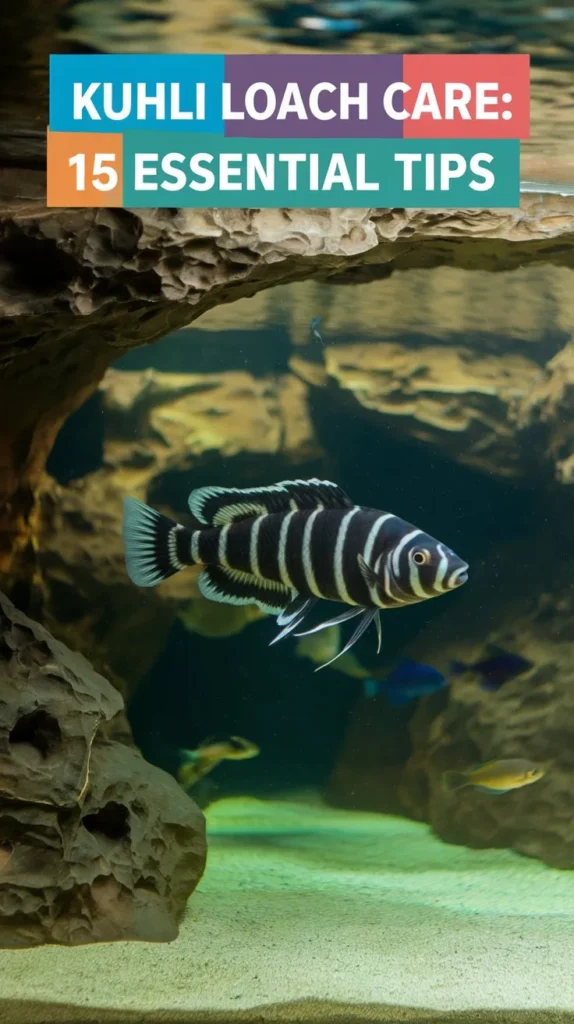

Hello, I’m Aria Cooper, the heart and soul behind Swimmy Buddies. As a devoted fish aficionado, I share my aquatic adventures and expertise to inspire your own underwater explorations. 🐠🌊


